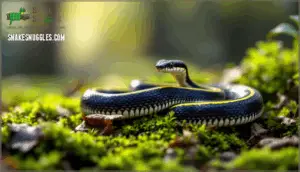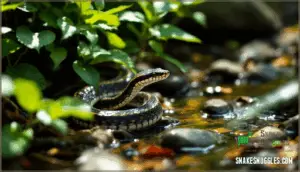This site is supported by our readers. We may earn a commission, at no cost to you, if you purchase through links.
 A garter snake can swallow a fish twice the width of its head, digest toxic newts that would kill most predators, and thrive in habitats ranging from coastal marshes to mountain meadows at 13,000 feet. These adaptable colubrids (genus Thamnophis) owe their success across North America to exceptional dietary flexibility and habitat tolerance.
A garter snake can swallow a fish twice the width of its head, digest toxic newts that would kill most predators, and thrive in habitats ranging from coastal marshes to mountain meadows at 13,000 feet. These adaptable colubrids (genus Thamnophis) owe their success across North America to exceptional dietary flexibility and habitat tolerance.
Their striped bodies appear wherever moisture, cover, and prey converge—whether that’s an untouched wetland or your backyard garden. Understanding their ecological requirements reveals why some populations flourish while others face decline, and what you need to know if you’re considering keeping one or simply want to appreciate the species living near you.
Table Of Contents
- Key Takeaways
- Garter Snake Habitat
- Garter Snake Diet
- Snake Physical Characteristics
- Garter Snake Behavior
- Garter Snake Distribution
- Frequently Asked Questions (FAQs)
- What is a garter snake’s favorite food?
- Can I keep a garter snake as a pet?
- Is it good to have garter snakes in your yard?
- Do garter snakes stay in one area?
- Are garter snakes dangerous to humans?
- How long do garter snakes live?
- Do garter snakes make good pets?
- What predators hunt garter snakes?
- How do garter snakes survive winter?
- How long do garter snakes typically live?
- Conclusion
Key Takeaways
- Garter snakes demonstrate exceptional adaptability through extreme dietary flexibility and habitat tolerance, thriving from sea level to 13,000 feet and consuming prey ranging from earthworms to fish twice their head width, with some populations developing remarkable immunity to tetrodotoxin levels 100 times higher than other populations.
- Their geographic success across North America stems from three key ecological advantages: moisture-rich microhabitats near water sources that provide thermoregulation and abundant prey, the ability to exploit human-altered landscapes like gardens and drainage ditches, and flexible home ranges that shift from 1.5 to 5 hectares depending on habitat quality and resource availability.
- Female garter snakes exhibit pronounced sexual dimorphism, often reaching nearly double the size of males (24-54 inches versus 18-26 inches), and employ ovoviviparous reproduction that produces 10-40 live young after 2-3 months of internal gestation, with neonates hunting independently within hours of birth.
- Winter survival depends on communal brumation behavior where thousands of individuals gather in shared hibernacula, sharing body heat while metabolic rates drop 95% and some species produce antifreeze-like proteins to maintain function near freezing temperatures.
Garter Snake Habitat
Garter snakes don’t need a single type of habitat to thrive. You’ll find them in an impressive variety of environments, from wetlands to woodlands and even your backyard.
Let’s explore where these adaptable snakes make their homes across North America.
Riparian Areas and Water Sources
When you’re tracking garter snakes in the wild, you’ll notice they rarely stray far from water’s edge. Riparian areas provide everything these snakes need—moisture-rich microclimate effects that regulate body temperature, dense riparian vegetation for cover, and abundant aquatic prey like frogs and fish.
Stream banks and wetlands offer premium den sites beneath rocks and logs, while water source proximity guarantees consistent hunting success.
However, habitat degradation from pollution and development threatens these critical garter snake habitat zones, making conservation of riparian areas essential for population stability.
Diverse Ecosystems and Environments
You’ll find garter snakes thriving in an impressive range of habitats—from the damp edges of marshes and ponds to surprisingly dry meadows, woodlands, and even rocky hillsides. Their habitat diversity reflects significant environmental adaptations that allow you to spot them in wetlands, deciduous forests, grasslands, and riparian zones across nearly every ecosystem type.
This environmental tolerance means they play essential ecosystem roles in controlling prey populations wherever they establish territories. Regional variations exist—some subspecies prefer aquatic environments while others favor terrestrial hunting grounds—but their adaptability remains consistent.
Understanding this diverse ecosystem presence helps you appreciate why conservation impacts affect different populations uniquely, depending on their specific garter snake habitat requirements.
Adaptability to Human-Altered Areas
While woodlands and wetlands showcase their natural range, garter snakes have proven equally comfortable in backyards, city parks, and drainage ditches where human development has reshaped the landscape. Their success in urban habitats stems from key adaptations to human activity patterns:
- Resource exploitation near compost piles and irrigation systems that attract prey
- Pollution tolerance allowing survival despite chemical runoff
- Habitat fragmentation movement between isolated green spaces
- Suburban encroachment acceptance, colonizing gardens and foundations
- Shelter utilization in rock walls, woodpiles, and landscaping features
This adaptability makes certain garter snake habitats persist even where development intensifies, though you’ll notice their diet shifts toward whatever prey thrives in modified environments.
Geographic Distribution and Range
Garter snakes thrive across a remarkable geographic range, from Canada’s Northwest Territories south through Mexico to Costa Rica. You’ll find 37 recognized species occupying habitats shaped by altitude variation—some like the western terrestrial garter snake span sea level to nearly 4,000 meters.
Climate influence and habitat fragmentation have created regional endemism, particularly in California where the San Francisco and giant garter snakes persist in isolated populations threatened by invasive species and development. The San Francisco garter snake is an endangered species endemic to California.
Garter Snake Diet
Garter snakes are opportunistic carnivores with a surprisingly varied menu. Their diet shifts based on what’s available in their environment, from slimy earthworms to fast-moving fish.
Let’s look at what these adaptable hunters eat, how they cope with toxic prey, and the clever strategies they use to catch their next meal.
Carnivorous Prey and Food Sources
What’s on the menu for these slender hunters might surprise you—garter snakes don’t just stick to one type of prey. Their feeding habits reflect considerable dietary adaptations, shifting between food sources based on what’s available in their environment. You’ll find their garter snake diet includes:
- Earthworms wriggling through damp soil
- Frogs and tadpoles near pond edges
- Small fish darting in shallow streams
- Slugs and snails in garden beds
- Crickets and beetles in grassy areas
Some populations show aquatic prey focus, while others emphasize insect consumption or even rodent predation. This prey venom tolerance and flexibility makes them successful hunters across diverse habitats.
Immunity to Toxins and Venom
Through millions of years of evolutionary arms race with toxic newts, garter snakes have developed remarkable TTX resistance. Some West Coast populations tolerate levels 100 times higher than their inland cousins. This geographic variation reflects local prey toxicity, with snake immunity mechanisms perfectly matched to newt defenses in their area.
Garter snakes evolved remarkable resistance to tetrodotoxin, with some West Coast populations tolerating newt toxins 100 times stronger than their inland relatives
The secret lies in genetic inheritance: amino acid substitutions in sodium channel genes (SCN4A, SCN8A, SCN9A) block tetrodotoxin binding. Nerve resistance evolved first, followed by muscle protection—a stepwise adaptation. Beyond garter snake venom for subduing prey, toxin processing allows liver storage without harm, turning deadly meals into potential chemical defenses. The snakes’ resistance is due to a single mutation on TTX receptor sites.
| Adaptation Feature | Evolutionary Advantage |
|---|---|
| Resistant sodium channels | Blocks paralysis from TTX-laden newts |
| Toxin sequestration in liver | Converts prey toxins into self-defense |
| Geographic resistance variation | Matches local newt toxicity precisely |
| Frog toxin resistance | Expands diet to include poisonous amphibians |
Feeding Habits and Hunting Strategies
Ever wonder how a snake without proper fangs is able to catch squirming earthworms or slippery frogs with such precision? As opportunistic hunters, garter snakes excel through three key hunting strategies:
- Prey detection via tongue flicking, analyzing chemical trails left by potential meals across their foraging range
- Ambush tactics combined with active pursuit, adapting methods based on prey type and hunting seasons
- Venom potency sufficient to subdue struggling victims through rear-positioned teeth
Their garter snake diet reflects significant dietary adaptations—from earthworms to small fish—with garter snake feeding habits shifting based on availability. These hunting strategies make them efficient predators despite their modest size.
Snake Physical Characteristics
Garter snakes aren’t hard to spot once you know what to look for. Their bodies tell a story of adaptation, with features that vary based on where they live and what challenges they face.
Let’s break down the key physical traits that make these snakes so distinctive.
Body Shape and Size Variations
When you compare male and female garter snakes side by side, the size difference can be striking—females often outsize males by nearly double, creating one of the most pronounced examples of sexual dimorphism you’ll find in North American reptiles.
Their slender body proportions stay consistent across species, though scale morphology varies by region. Most garter snakes stretch 18-26 inches, but size range extremes span from barely one foot to nearly five feet. Weight variance matters too—most tip the scales under one pound.
| Characteristic | Males | Females |
|---|---|---|
| Body Length | 18-26 inches | 24-54 inches |
| Weight Range | 3-5 ounces | 5-10 ounces |
| Growth Rate | Slower maturation | Faster, larger growth |
| Body Proportions | Slender, uniform | Sturdy, thicker mid-body |
| Sexual Maturity | 1-2 years | 2-3 years |
Color and Pattern Variations
If you’ve ever wondered why your backyard garter snake looks completely different from your neighbor’s, the answer lies in their striking color palette—a stunning spectrum that shifts with geography, genetics, and local habitat. Regional morphs produce distinct coloration patterns, from bright longitudinal stripes in yellow, green, or red to subtle checkered patterns on dark backgrounds.
Pattern inheritance creates variations like melanistic garter snakes (nearly black) and albino garter snakes (lacking dark pigment). Color mutations occur naturally, giving you:
- Classic striped patterns with three bold lines
- Checkered designs replacing stripes entirely
- Blotched morphs with irregular markings
- Solid-colored variants with minimal patterning
These garter snake physical characteristics help them blend into local environments.
Scale Differences and Geographic Variations
Look closely at a garter snake’s scales, and you’re looking at a living map—each ridge, count, and arrangement tells the story of where that snake calls home. Scale morphology shifts across the garter snake geographic range, producing regional adaptations that help subspecies survive in different snake habitats.
You’ll notice pattern divergence between coastal and inland populations, with hybridization zones creating intermediate forms. Island populations often develop unique scale counts, while geographic differences reflect the environmental pressures shaping garter snake habitats—from Mexican Pacific lowlands to Canadian wetlands.
These variations are driven by the garter snake diet and local conditions, which together fuel striking evolutionary changes.
Garter Snake Behavior
Garter snakes display fascinating behaviors that help them survive in diverse environments. From their hunting techniques to their winter routines and breeding patterns, these reptiles have adapted strategies that allow them to thrive across North America.
Let’s explore the key behavioral traits that define how garter snakes interact with their world.
Ambush Predation and Escape Tactics
Though garter snakes might look like they’re just sunbathing in your yard, they’re actually master tacticians armed with a toolkit of survival strategies refined over millions of years. When hunting prey like earthworms or small amphibians, these snakes use their camouflage to blend into their garter snake habitat, then strike with astonishing speed—often faster than you can blink. Their venom effectiveness, while mild, helps subdue struggling meals.
When predators threaten, you’ll see defensive postures kick in: they flatten their bodies, release musk, or coil into an S-shape ready to flee. Unlike some reptiles, garter snakes don’t use tail autotomy, but their adaptations work brilliantly.
Their survival toolkit includes:
- Ambush hunting – Remaining motionless until prey wanders within strike range
- Rapid retreat – Darting into dense vegetation or water when danger appears
- Chemical warfare – Releasing foul-smelling musk to deter attackers
- Visual deception – Using striped patterns to confuse predators during escape
- Threat displays – Flattening heads and hissing to appear more intimidating
Social Behavior and Brumation
Garter snake behavior reveals surprising social complexity. During brumation (hibernation for reptiles), thousands of snakes gather in communal dens called hibernacula, with Manitoba sites hosting up to 10,000 individuals.
This denning fidelity isn’t just crowding—social hierarchies emerge around older females who become central figures in these networks. Aggregation factors like age, sex, and familiarity shape these groups, which average 3–4 snakes but can reach 46.
Brumation physiology is striking: metabolic rates drop 95% as temperatures fall, yet snakes maintain body mass through winter. Climate influence dictates timing, but pheromonal cues help them reunite with preferred groupmates year after year.
Mating and Reproduction Habits
As soon as the snow melts and temperatures climb above 50°F, male garter snakes emerge from their winter dens with one thing on their minds: finding a mate. During Mating Season (March through May), you’ll observe dramatic mating balls where dozens of males compete for receptive females through intense courtship behavior. This breeding spectacle showcases clear Sexual Dimorphism—females are noticeably larger than males.
Their Ovoviviparous Reproduction means females retain eggs internally, giving Live Birth to 10–40 live young after 2–3 months gestation. Remarkably, neonates require no parental care—they hunt independently within hours. Females reach sexual maturity at 2–3 years, maintaining Reproductive Lifespan throughout their 4–10 year lives.
Garter Snake Distribution
Garter snakes span an impressive geographic range across North America and into Central America, with different species claiming their own territories from coast to coast.
Their distribution patterns reflect millions of years of adaptation to diverse climates, elevations, and habitat types. Let’s explore where you’ll find these adaptable serpents and what factors shape their range.
North American and Central American Ranges
You’ll find these adaptable serpents spread across nearly every corner of North America—from the icy reaches of Canada’s Northwest Territories all the way down to the steamy wetlands of Costa Rica. This impressive garter snake distribution spans nearly every U.S. state, all Canadian provinces, and extends into Mexico and Central America.
While habitat fragmentation and invasive species increasingly threaten traditional territories, ongoing conservation efforts aim to preserve critical corridors where range overlap among Thamnophis species creates biodiversity hotspots, even as climate impacts shift historical boundaries northward.
Coastal and Terrestrial Habitats
Whether hugging rocky shorelines where ocean spray meets serpentine scales or winding through inland meadows far from any saltwater breeze, garter snakes occupy an astonishing range of habitat types that would challenge most reptiles. Coastal habitats support specialized populations targeting fish and crustaceans, while terrestrial habitats favor earthworm and amphibian specialists—this habitat overlap reveals how microhabitat selection and prey abundance drive garter snake habitat diversity. Human impact threatens habitat quality, making conservation strategies essential for protecting both garter snake habitats and distribution:
- Coastal populations hunt intertidal zones during low tide cycles
- Terrestrial snakes thrive in grasslands with dense rodent burrows
- Wetland borders provide best foraging for both ecotypes
- Rocky outcrops offer essential thermal regulation sites
- Riparian corridors connect fragmented habitat patches effectively
Altitude and Environmental Tolerance
From sea-level marshes to windswept peaks exceeding 13,000 feet, garter snakes demonstrate remarkable altitudinal limits that set them apart from most North American reptiles. Western terrestrial garter snakes have conquered some of the highest elevations recorded for snakes on the continent, while wandering garter snakes patrol alpine meadows above 10,000 feet—habitat quality at these extremes demands serious physiological adaptations.
Their thermal tolerance includes antifreeze-like proteins that keep blood flowing near freezing, and seasonal shifts trigger communal brumation in limestone dens where hundreds huddle through harsh winters.
Geographic distribution spans from northern Mexico to central Canada, with climatic distribution shaped by their ability to maintain body temperatures 5–8°C above ambient air during gestation. Environmental tolerance this striking explains why you’ll encounter these adaptable serpents in deserts, rainforests, and everything between.
Home Range Size and Quality
Individual garter snakes claim territories that shift in size by up to three times depending on whether they’re living in prime habitat or making do with patchy, fragmented landscapes. In areas where prey abundance peaks—think wetlands teeming with frogs and earthworms—you’ll find home ranges shrinking to just 1.5 hectares.
Habitat fragmentation forces expansion up to 5 hectares as snakes compensate for scattered resources. Territory overlap increases where habitat quality declines, leading to resource competition that tests their range fidelity and survival tactics within garter snake habitat.
Frequently Asked Questions (FAQs)
What is a garter snake’s favorite food?
Regarding prey preference, earthworms dominate the garter snake diet. These slender hunters actively seek worms in moist soil, though they’ll opportunistically consume amphibians, insects, and fish based on seasonal diet shifts and food availability.
Their mild venom effects help subdue prey, while toxin immunity protects them when eating toxic toads.
Can I keep a garter snake as a pet?
Captivity transforms a wild hunter into a dependent companion, requiring you to balance legality with ethics. You can keep garter snakes as pets in most states, but proper enclosure needs, care concerns, and dietary sourcing demand commitment—especially finding fresh fish and amphibians regularly.
Is it good to have garter snakes in your yard?
Having these beneficial yard visitors around means you’ll enjoy natural pest control without lifting a finger.
They consume slugs, earthworms, and insects that threaten your garden ecosystem health, while remaining completely harmless to children and pets who might encounter them.
Do garter snakes stay in one area?
Think of garter snakes as creatures with flexible zip codes rather than permanent residences.
These snakes maintain territorial ranges that shift with seasonal movement and habitat quality, commonly covering 3 to 6 miles daily as they track food sources and environmental conditions throughout their home range size.
Are garter snakes dangerous to humans?
Garter snakes pose minimal risk to you. While they do produce mild venom through rear teeth, bites rarely occur and cause only temporary irritation—comparable to a bee sting—with no serious medical consequences for humans.
How long do garter snakes live?
In the wild, most garter snakes reach an average age of four to ten years.
Lifespan factors like predators, disease effects, and habitat quality influence longevity, while captivity longevity often extends beyond typical wild survival rates.
Do garter snakes make good pets?
You might be surprised how often people consider these striped serpents for their collection, but captive-bred garter snakes suit experienced keepers better than beginners.
You’ll face care requirements like proper enclosure setup, consistent feeding schedules, and veterinary access. Their temperament concerns remain minimal since they tolerate being held well, though legal restrictions and ethical considerations about captivity challenges vary by region.
What predators hunt garter snakes?
Hawks, owls, raccoons, foxes, and larger snakes actively prey on garter snakes. Avian predators strike from above during daylight, while mammalian predators hunt them at night.
You’ll also find reptilian predators like kingsnakes targeting them as food sources.
How do garter snakes survive winter?
Hundreds of garter snakes packed into a single rocky den might seem chaotic, but it’s actually a life-saving strategy. When winter arrives, you’ll see these snakes enter brumation—a hibernation-like state—gathering in communal dens called hibernacula beneath rocks, building foundations, or abandoned burrows.
They share body heat, slow their metabolism, and rely on energy reserves accumulated during warmer months. Some species produce antifreeze-like proteins that improve cold tolerance, boosting survival rates through harsh conditions until spring temperatures trigger their emergence.
How long do garter snakes typically live?
You can expect your garter snake to live between four and ten years. Lifespan factors like predators, habitat quality, diet, and environmental stressors greatly affect mortality rates.
Females generally outlive males due to lower energy costs outside the breeding season.
Conclusion
Necessity is the mother of invention”—and for garter snakes, that necessity shaped striking survival tools. Their success story isn’t luck—it’s evolutionary brilliance meeting environmental opportunity.
Your understanding of garter snake diet and habitat now reveals why these striped opportunists outperform specialist predators in changing landscapes. Whether you’re creating backyard refuges, maintaining captive specimens, or simply respecting the snakes threading through wetland edges, you’re engaging with animals whose flexibility mirrors nature’s first rule: adapt or vanish.














